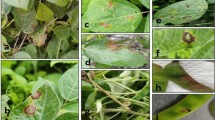Abstract
The disease septoria tritici blotch of wheat is initiated by ascospores of the teleomorph Mycosphaerella graminicola or pycnidiospores of the anamorph Septoria tritici. We report for the first time the presence of the teleomorph, M. graminicola, in Denmark. With the objective of elucidating the importance of the teleomorph for the development of septoria tritici blotch, data on the occurrence of fruit bodies of the anamorph (pycnidia) and the teleomorph (pseudothecia) stages were collected over three growing seasons. Pseudothecia were present in the springs, however, high numbers of pseudothecia compared to pycnidia were not observed until July, too late to influence the epidemic. On an individual leaf layer, pycnidia were observed well before pseudothecia. As the leaves aged, progressively higher proportions of fruit bodies were observed to be pseudothecia. The period from the appearance of pycnidia to detection of pseudothecia was estimated as 29–53 days. At harvest, high proportions of sporulating fruit bodies in the crop were pseudothecia, suggesting that the primary source of inoculum for new emerging wheat crops in autumn is likely to be ascospores.
Similar content being viewed by others
References
Bathgate JA and Loughman R (2001) Ascospores are a source of inoculum of Phaeosphaeria nodorum, P. avenaria f. sp. avenaria and Mycosphaerella graminicola in Western Australia. Australasian Plant Pathology 30: 317-322
Brown JS, Kellock AW and Paddick RG (1978) Distribution and dissemination of Mycosphaerella graminicola (Fuckel) Schroeter in relation to the epidemiology of speckled leaf blotch of wheat. Australian Journal of Agricultural Research 29: 1139-1145
Chamberlain M and Ingram DS (1997) The balance and interplay between asexual and sexual reproduction in fungi. Advances in Botanical Research 24: 71-87
Cordo CA, Simon MR, Perelló AE and Alippi HE (1999) Spore dispersal of leaf blotch pathogens of wheat (Mycosphaerella graminicola and Septoria tritici). In: van Ginkel M and Krupinsky J (eds) Septoria and Stagonospora Diseases of Cereals: A Compilation of Global Research (pp 98-101) CIMMYT, Mexico, DF
Cunfer BM and Ueng PP (1999) Taxonomy and identification of Septoria and Stagonospora species on small grain cereals. Annual Review of Phytopathology 37: 267-284
Eriksen L, Shaw MW and Østergård H (2001) A Model of the effect of pseudothecia on genetic recombination and epidemic development in populations of Mycosphaerella graminicola. Phytopathology 91: 240-248 and Erratum Phytopathology 91: 519
Eyal Z (1971) The kinetics of pycnospore liberation in Septoria tritici. Canadian Journal of Botany 49: 1095-1099
Eyal Z, Scharen AL and van Ginkel M (1987) The Septoria Diseases of Wheat: Concepts and Methods of Disease Management, CIMMYT, Mexico
Glazek M and Sikora H (1998) The occurrence of Septoria tritici and its teleomorph Mycosphaerella graminicola in the region of Upper Silesia in 1996. Journal of Plant Protection Research 38: 23-29
Gough FJ (1978) Effect of wheat host cultivars on pycnidiospore production by Septoria tritici. Phytopathology 68: 1343-1345
Hunter T, Coker RR and Royle DJ (1999) The teleomorph stage, Mycosphaerella graminicola, in epidemics of septoria tritici blotch on winter wheat in the UK. Plant Pathology 48: 51-57
Kema GHJ, Verstappen ECP, Todorova M and Waalwijk C (1996) Successful crosses and molecular tetrad and progeny analysis demonstrate heterothallism in Mycosphaerella graminicola. Current Genetics 30: 251-258
McDonald BA and Martinez JP (1990) DNA restriction fragment length polymorphisms among Mycosphaerella graminicola (anamorph Septoria tritici) isolates collected from a single wheat field. Phytopathology 80: 1368-1373
Pedersen JB, Nielsen GC, Petersen PH, Kristensen H and Jensen JE (2000) Vintersæd. In: Pedersen CÅ (ed) Oversigt over Landsforsøgene (pp 17-101) The Danish Agricultural Advisory Centre, Århus, Denmark
Sanderson FR (1972) A Mycosphaerella species as the ascogenous state of Septoria tritici Rob. and Desm. New Zealand Journal of Botany 10: 707-710
Sanderson FR (1976) Mycosphaerella graminicola (Fuckel) Sanderson comb. nov., the ascogenous state of Septoria tritici Rob. apud Desm. New Zealand Journal of Botany 14: 359-360
Sanderson FR and Hampton JG (1978) Role of the perfect states in the epidemiology of the common Septoria diseases of wheat. New Zealand Journal of Agricultural Research 21: 277-281
Scott PR, Sanderson FR and Benedikz PW (1988) Occurrence of Mycosphaerella graminicola, teleomorph of Septoria tritici, on wheat debris in the UK. Plant Pathology 37: 285-290
Shaw MW (1990) Effects of temperature, leaf wetness and cultivar on the latent period of Mycosphaerella graminicola on winter wheat. Plant Pathology 39: 255-268
Shaw MW and Royle DJ (1989) Airborne inoculum as a major source of Septoria tritici (Mycosphaerella graminicola) infections in winter wheat crops in the UK. Plant Pathology 38: 35-43
Author information
Authors and Affiliations
Rights and permissions
About this article
Cite this article
Eriksen, L., Munk, L. The Occurrence of Mycosphaerella graminicola and its Anamorph Septoria tritici in Winter Wheat during the Growing Season. European Journal of Plant Pathology 109, 253–259 (2003). https://doi.org/10.1023/A:1022851502770
Issue Date:
DOI: https://doi.org/10.1023/A:1022851502770




